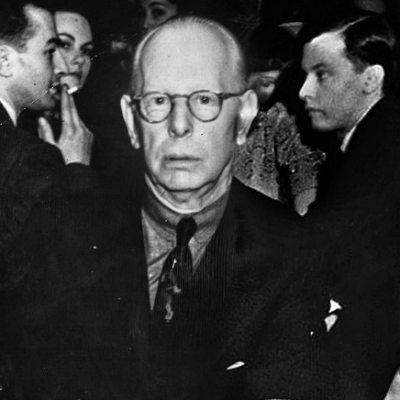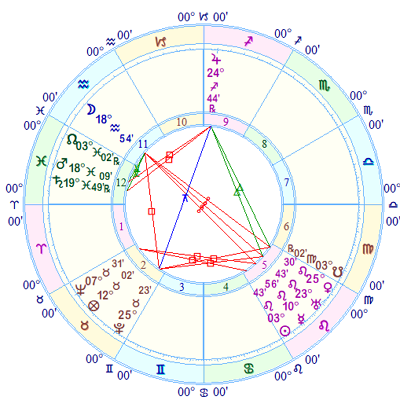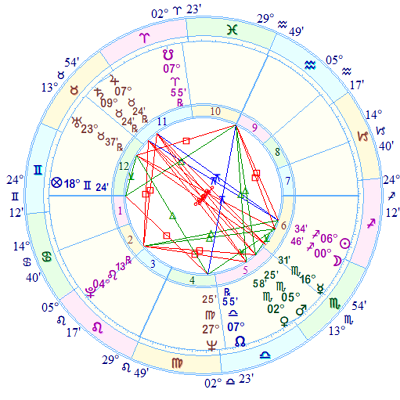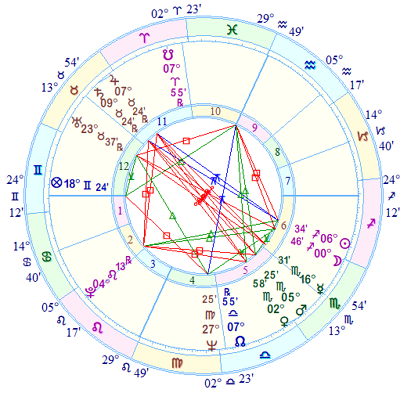
Jesse Livermore is often regarded as one of the best stock market traders ever. His biography, Reminiscences of a Stock Operator, is read assiduously by budding traders, and they hope that his 25 rules will make them rich. Livermore certainly made a lot of money, but he lost his fortune several times over, and at the age of 63 he committed suicide.
Livermore was born on July 26 1877, in Shrewsbury, Massachusetts. Here’s his horoscope, set for noon:

Livermore started betting on stock market movements when he was 15, so at a very young age he became familiar with price action. He was helped by his amazing intuition, and he was prepared to back his hunches with hard cash. He went short on railroad stock immediately before the 1906 San Francisco earthquake, and he made around one hundred million dollars from the Wall Street crash in 1929.
So what should we look for in his horoscope? He had four planets in Leo: the Sun, Mercury, Venus and Uranus. Leo is a fire sign, and it is therefore about intuition. Another Leo was psychiatrist and mystic Carl Jung, who was born exactly two years earlier, on July 26 1875. At the end his life Jung was asked whether he believed in God. He replied “I know… I don’t need to believe… I know“. Livermore, like Jung, just knew. However one has to understand that the intuition that these two men demonstrated was not vague and emotional – it was born of Fire rather than Water. Livermore did not get a vague feeling that he needed to short a railway stock just before the San Francisco earthquake. He just knew that it was the right thing to do.
When Leo is working well it’s very confident. In terms of Livermore, this related not just to his final decision to trade, but also to his methods. He had a method for choosing what and when to trade, and he had absolute confidence in this method. Or in modern parlance, he had a trading plan that he was very comfortable with.
If you look at trading forums, there is endless discussion about how to choose trades, whether you look at fundamentals, such as the economy or a company’s balance sheet, or whether to focus on graphs. If you are constantly moving from one method to another, then it is difficult to get any traction. What Livermore’s method seemed to boil down to was identifying a trend, making a small, testing bet, then increasing his exposure as the trend developed. It sounds easy, but one has to remember that he had experience as well as intuition.
I should also mention that financier George Soros was a Leo. In 1993 he had a strong feeling that the British Pound was over-valued, and he made a huge bet that it would fall. His hunch was right, and he made a massive amount of money.
Livermore’s Leo planets, in particular Venus and Uranus, made a trine aspect to Jupiter in Sagittarius. Jupiter is the planet of optimistic speculation, and in Sagittarius it can bring plenty of luck. The trine would also have helped Livermore’s intuition – he’d be able to connect the dots super-quickly. There would be little or no intellectualizing, and the correct course of action would be obvious.
Another way of looking at Livermore’s chart is through the elements and quadruplicities. The four elements are Fire, Earth, Air and Water, and the three quadruplicities are Cardinal, Fixed and Mutable. I do a simple count of the seven traditional planets. In Livermore’s case he had four of the seven planets in Fire signs, namely the Sun, Mercury, Venus and Jupiter. At the other extreme, he had no traditional planets in the Earth signs of Taurus, Virgo and Capricorn.
One can look at the lack of Earth in two ways. Firstly, a lack of an element can manifest as a desire for the blank to be compensated for. Meaning that Livermore had a great desire for money and material things, even if he didn’t trully understand their value. Secondly, he was perhaps detached from the millions he was making and losing on the markets. It was a game, and the cash sums weren’t entirely real. Ironically, this may have helped him become successful. He wasn’t worrying about the actual money, he wasn’t afraid and he could let his profits run.
The quadruplicities are also interesting. Livermore had four traditional planets in Fixed signs: the Moon in Aquarius, and the Sun, Mercury and Venus in Leo. The fixed signs keep moving, in a single direction, like a juggernaut. He may have known how to exit a trade, but he couldn’t stop trading, and at the same time he had total self-confidence. Also, trading was his life, and when he hit a losing streak he only stopped when he was cleaned out.
In this light, it is important to comment on the Full Moon in his chart: his Sun in Leo opposition his Moon in Aquarius. From an aspect point of view, it is a very wide opposition, with an orb of 15 degrees. However, it always matters when people have the Sun and the Moon in opposite signs. It can represent big swings – happy/sad, profit/loss, rich/poor. This was the pattern of his life, which may also have had a psychological dimension. When he shot himself on November 28 1940 he was suffering from clinical depression, and there is some evidence that he was bipolar.
This brings me to his Mars-Saturn conjunction in Pisces. This conjunction is depressive, and can be associated with death. Particularly as his Sun in Leo was making an 135-degree aspect to both planets, and therefore aspected the Mars-Saturn midpoint. I suspect that death was never far from Livermore’s mind, and again, this may have helped him in his trading. I know it’s a controversial suggestion, but maybe he felt that he could take risks, because if things got too bad, he could always kill himself. Nonetheless, he didn’t commit suicide because he was penniless. Most of his fortune had gone, but he still had 5 million dollars in annuities, which equates to 100 million dollars in today’s money.
The connection between his Sun on the Mars-Saturn midpoint and his suicide is supported by the planetary line-up on the day of his death. Here’s the death horoscope, set for New York at 5.33 pm:


Looking at the charts for his birth and death – the former is set for noon – his natal Mars-Saturn midpoint is at 18 degrees 59 Pisces, which makes hard, 45-degree aspects to 3 degrees 59 of the Fixed signs. On November 28 1940 at 5.33 pm, the time of Livermore’s suicide, transiting Pluto was at 4 degrees 13 minutes Leo. In other words, close to a conjunction of his natal Sun, at 3 degrees 34 Leo. At the same time Venus and Mars were close to a conjunction, in Scorpio. To be precise, Venus was at 2 degrees 58 Scorpio and Mars was at 5 degrees 25 Scorpio. The transiting Venus-Mars midpoint was therefore at 4 degrees 12 minutes Scorpio, one minute short of a square with transiting Pluto. This is a good example of inner planets triggering an aspect from a slow-moving outer planet, in this case Pluto.
I mention Livermore’s death because it illustrates the fact that you have to understand the natal chart before trying to make forecasts. He had a Mars-Saturn conjunction, which the Sun aspected by sesquiquadrate (135 degrees). Alfred Witte uses three words to describe this combination: “Death through wounding”. That was the potential shown by the chart, which was there the moment he was born. Then at the time of his death, this midpoint configuration was hit by Pluto, Venus and Mars. Incidentally, in the Solar Return prior to his suicide, there was a close Mars-Saturn square. This means that we have a repeated signature.
Another signature, in the suicide chart, is an opposition between Mars and Saturn, which had Jupiter exactly squaring it. Witte wrote of Jupiter on the Mars-Saturn midpoint as follows: “Pleasant interruption of work. Vacations. Quick death”. The photo at the top of the article was taken the day before Livermore’s suicide. According to Richard Smitten, the photographer asked Livermore for permission to take the shot, and he replied “Of course you can… but it’s the last picture you will take, because tomorrow I’m going away for a long, long time”.
Finally, I can understand why traders want to emulate Jesse Livermore. However can they cherry-pick the parts of his personality they like, and discard the rest? I think not. To appreciate Livermore’s success, you have to understand the whole person, and in this sense, astrology can be useful.
Fascinating. Thanks.
RE: Livermore: The resolution for suicide. Adding these comments to the observations you’ve made in this very interesting article.
NATAL FACTORS:
1. Natal Mars and Saturn conjunction (possibly indicating the Bipolarity of accelerator and brake?) semisextile the Moon (emotional well-being)
2. Natal Uranus square Pluto
Uranus is associated with abrupt developments, which may be fortunate or disastrous. Pluto is notable for implacable will and the determination to live on one’s own terms and with notable indifference to the opinions of others.
3.Natal Jupiter and Pluto are inconjunct. Jupiter often manifests as driving ambition, inflated expectations, and envious self-comparison with others. Taken together, these make the native subject to narcissistic injury and emotional imbalance, whenever the self-designated markers of success and status, often exaggerated, fall below the native’s do-or-die standard. Pluto suggests implacable will and the determination to live on one’s own terms and with notable indifference to the opinions of others.
TRANSITING FACTORS on the day of suicide.
1. Transiting Uranus, associated with abrupt developments, exact square to natal Uranus.
2. Transiting Uranus conjoined natal Pluto in July, subsequently turned retrograde to conjoin Pluto again in October, and then retreated from Pluto to a distance of 2 degrees, only to square natal Uranus.
3. Mars squared the Sun, another timing factor, also suggesting violence.